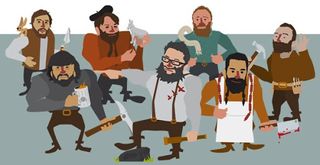Dwarf Fortress beginner's guide
How to Dwarf Fortress, for brand new baby urists.

You've completed the tutorial, but the yawning void of Dwarf Fortress is still open ahead of you, a thousand confusing buttons and strange untapped systems awaiting. It's going to be a good time, but let's ease you in some more with a bit of advice. Just be patient with yourself—and don't blame your dwarves when wild animal/goblin/dragon attacks derail a new fort.
The thing you might not have done during the tutorial I'm going tell you right now is this: dig deeper. Ensure you're making your core base at least the first few layers of pure stone you dig into. Depending which biome you're in, that might be a gibberish sentence to you because everything is rocks, but stick with me.
Another thing you should know going in is that the simulation of Dwarf Fortress is synced to the frames-per-second, you know, FPS, that it's running at on your computer. If things move too fast for you when it's unpaused, and they might well in the early game, you can limit that run speed to 60 or lower in the settings to help you keep up.
Finally, the ☼Dwarf Fortress Wiki☼ hasn't fully migrated to the new premium release yet, but a lot of its advice is golden wisdom and good humor built up over 15 years of the game's public versions. Until you can see v0.50 articles, be sure you're on v0.47 across the top and be aware some stuff, like Zones and Rooms, is going to sound entirely different in old-version parlance because those systems were reworked to go along with the new interface. (It's a good thing, trust me.)
A vital core concept
You won't get far in Dwarf Fortress until you understand how each tile is composed. Tiles effectively have two parts: the block, and the floor. Mining a tile removes the block, Channeling a tile removes the block and the floor—or just the floor if the block was already gone—and makes a ramp on the floor below. It can be tricky to picture how this works over multiple Z-levels, but you'll get the hang of it.
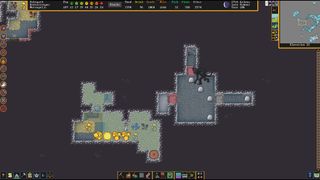
Dwarven ergonomics
Let's get some basics established, too: units move from one tile to another at variable speeds based on their species and the like. They can move diagonally, and are even able to squeeze between the corners of two filled tiles. The only way to guarantee something can't move out of a tile is a perfect box of either natural wall or constructed walls, as even locked doors can be battered down by stronger creatures like trolls.
For a moving dwarf, one tile is one tile. It doesn't matter if that tile is flat ground, stairs, or a ramp. Other creatures and dwarves can get in their way, greatly slowing them down, so it's often good to make major hallways 2-3 tiles wide, and build major staircases in 2x2 blocks. Some players base their whole fortress around a central, 3x3 spine staircase, and that's a pretty solid idea for budding fortress architects.
The biggest gaming news, reviews and hardware deals
Keep up to date with the most important stories and the best deals, as picked by the PC Gamer team.
I'm spelling out exact tile movement and emphasizing staircases because a key bit of design in Dwarf Fortress is about making your underground base at least somewhat vertical. Two rooms or hallways connected by a staircase have, effectively, no tiles between them—a stockpile of metal beneath your blacksmiths can sometimes be better than one beside it. Dwarves are perfectly happy to have their living and eating quarters directly above or below their working spaces.
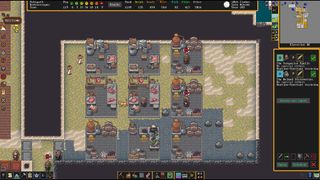
Food and drink
Your first dwarves can get along for quite a while on fishing, hunting, and foraging in most biomes, picking up wild produce and turning it into booze with the Still you built during the tutorial. Booze is vital. Your dwarves can theoretically drink water but it'll rapidly make them murderously upset.
Farming is pretty straightforward once you get a few quirks out of the way. You can place a field on any soil, under Build-Workshops-Farming-Farm Plot. Your farms don't need to be bigger than 2x2 or 4x4. Dwarven farms are absurdly productive and even a small, unfertilized plot growing Plump Helmets will feed a lot of dwarves.
To grow proper dwarven crops underground, which you probably started with seeds for, you'll want an underground area with a soil floor: silt, sand, loam, clay, mud, whatever. That's easy to get in some biomes, comprising the first few z-levels beneath the earth, and very hard to find in others. If you can't get it you'll need to do some dwarven irrigation by making wooden buckets at a carpenter shop, digging a hole with Channel, then designating that space as a Pond in the zones menu. Stop before it's more than 2/7 full of water for a nice coating of fertile mud.
You'll also want a kitchen. Dwarves eat a few meals per season, so use the Work Orders menu to set up a recurring order of Fine Meals, five or six times your number of dwarfs, which will use three units of food and provide pretty good variety to your dwarves. Don't worry about anything fancier for now.
(If you're short on booze already, go ahead and go into the Labor menu, then the Kitchen tab, and turn off the option to let your dwarves use booze to cook. Disable using seeds to cook while you're at it, unless it's something like almonds or walnuts.)
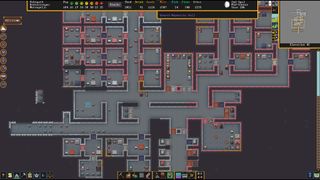
Common spaces
Dwarves love to eat and drink, so placing down a nice enclosed room with smoothed stone walls, a couple tables, and some chairs early on is key. Designate it a Dining Hall using the zones menu and it'll become a hub in no time. A nicely decorated, smoothed, and engraved dining hall is a great way to get your dwarves some useful positive thoughts. (Hot tip: put storage next door and customize it to only accept Prepared Meals and Drinks.)
Some of the other most important things you can actually make in Dwarf Fortress are all made using a somewhat-deceptive system: By placing a Meeting Area. Depending on what it's filled with, a Meeting Area can become a meeting hall, statuary garden, zoo, museum, or memorial to the fallen. It's where idle dwarves and stray pets will congregate, so getting one made underground will get them out of the nasty wild and into the safe shade faster.
Eventually you'll want a Hospital, Temple, Guildhall, Tavern, or similar structure. All of those are made by taking a Meeting Hall and clicking the Shield-Shaped button to add it to one. These are basically an overarching collection of rooms that work together. Taverns like to have extra rooms for visitors and long-term residents to sleep in, for example, but a hospital can do fine as one big room of beds, chests, and such—just make sure it has access to fresh water, since dwarves will actually drink that when sick and use it to wash wounds. Be sure to leave a space of at least 5x5 open in any Tavern or Temple, so that people have space to dance.
Bedroom design
Speaking of bedrooms, you've probably made them too big. The vast majority of dwarves will be perfectly happy with a door-enclosed one-tile chamber containing nothing but a bed. If you're a humanitarian, like me, then building 2x2 bedrooms is just fine, leaving space for you to add a cabinet for possessions, or even a piece of personalized statuary later. Larger bedrooms are an extravagance best reserved for the nobility and fortress officials—we'll get to them later.
You can also use a dormitory as a stopgap, just a big room with nothing but beds in it. It is considered polite to give this room doors.
Note that dwarves are very sound sleepers, only disturbed by the racket of mining quite nearby. Feel free to have bedrooms connected directly to each other, since passing dwarves won't bother each other. This is an area where thinking vertically pays dividends, as stacking bedrooms around a central staircase can mean they're much more centralized than bedrooms strung out along long, narrow, and congested hallways. You can dive as deep into this optimization as you like, with some players constructing fractal hives, stacks of multi-entrance "sandwich" rooms using stairs and hatch covers, or complex windmill patterns.

The labor menu
As part of the tutorial you got your Work Orders up and running, allowing you to create jobs that are automatically doled out to the correct workshops. A big thing you'll want to do next is set up your Labor menu, the hammer button in the bottom left, which will determine who gets to do what and when.
The key to remember is that your dwarves have skills they gain experience in over time, and increased skills can have a huge effect on the quality of the outcome. Not so much for a Legendary Wood Burner or Soap Maker, but the wares of a Legendary Weaponsmith are extremely valuable. To this end you can create work details, giving them custom names and sets of jobs. For now, some new work groups like Carpenter, Blacksmith, Mason, Chef, and Brewer should ensure a specialist is looking after the basics.
Quality
What do the plus signs around an item mean? Asterisks? Little suns? The symbols around an item's name in Dwarf Fortress are its quality, which improves nearly all its game statistics, how much it's worth, and how happy a dwarf can get when they see it. Most any crafted good has a quality, from statues to dyed thread. Normal-quality items have no symbol around them, just a name, like Oak Bed. There are seven in total, in order from least to best: -Well-crafted-, +Finely-crafted+, *Superior Quality*, ≡Exceptional≡, and ☼Masterful☼.
The seventh level of quality, a named artifact, comes from strange moods. These are heralded by a special sound effect and right-hand anvil popup, whereafter the dwarf in question will try to claim a crafting workshop and make some object they've seen in a vision. You can click on these dwarfs to see a hint at what kind of workshop they want and what kind of materials they need. Try to get them those things ASAP—a dwarf that can't fulfill its strange mood usually becomes irrecoverably violent.
Sometimes items will also have double angle-brackets brackets around them, «item name», which means they've been decorated with something like gems, shells, or horn. Another set of symbols outside those brackets is the quality of the decorations themselves.
You can use the spyglass in an item's panel to see a physical description that shows all the quality-related information.
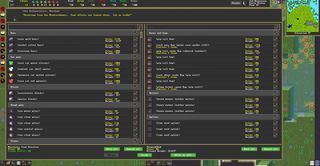
Trade, nobles, and growth
Make sure to build a stone trade depot somewhere that a 3x3 wagon can move clearly to it. That might be outside, a sheltered cliffside cave, or down a ramp to some kind of fancy underground garage. I specify stone because if it ever burns down while full of traders and trade goods you will have a lot of fun. Fun in the sense of the Dwarf Fortress motto, that is. ("Losing is fun!")
Traders are your lifeblood, and pumping out even crappy bone crafts will let you purchase a vital variety of booze, food, and finished goods from them. You should get at least a dwarven caravan from the mountainhomes every fall, before winter sets in, but local elves may visit in the spring and humans in the summer. Humans are great, but their clothes, weapons, and armor are all too big for dwarves to wear. Elves can be useful, and their clothes fit, but don't offer them anything made from an animal or plant, including glass or soap made with ash—they'll be very offended and at best may never come back, at worst come back with weapons. (Alternately, do this on purpose. Your call.)
The dwarf caravan is special, because the liaison from the Mountainhomes will track your progress with the bosses back home. Each time they visit they'll record your outpost's overall wealth and send it home, which affects how many migrants show up in waves of new dwarves. This is how you get your fort promoted, adding new titles of nobility.
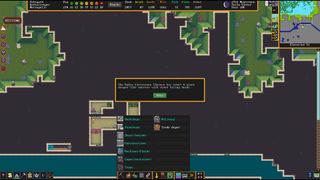
Visitors
As you build more and more, and dig deeper, new kinds of people will show up at your fort. The first kind will probably be wandering monster hunters and beast slayers starting when you breach a large cavern below the earth. Some of them will petition for residence, but how should you decide to let them stay or not?
Check their name in the petition, which will pop up in the top left, and then open the creatures menu with the dwarf head button in the bottom left.
How do I make metal?
You'll need a Wood Kiln, a Smelter, and a Metalsmith's Forge. At the Wood Kiln, use some trees you've cut down to make charcoal. Then, at the Smelter, tell your dwarves to either make bars from ore or smelt a specific ore by name. Finally, the metalsmith's forge will let you choose a thing to make, then you can use the spyglass symbol beside the order to specify what metal to make it out of.
Where does ore come from? You mine it underground, duh. It's most likely to be found in layers of sedimentary or igneous rocks like siltstone, dolomite, chert, and shale, or among igneous rocks like basalt and rhyolite. Dwarf Fortress mimics real-world mineralogy, and you're inevitably going to learn some of it as you go along here. This is not a joke. Neither is the next bit of basics…
Soap
Your dwarves are disgusting and filthy. Find them a source of fresh water and make some soap. You'll need a Wood Furnace to make ash, a Kitchen to turn animal fat into tallow, an Ashery to turn ash into lye, and a Soap Maker's workshop. This might seem absurd, but soap and clean water are essential to helping your dwarves keep clean and stay happy. More than that, however, soap is required for doctors to clean wounds, and without it even the smallest infected scratch can prove deadly within a few seasons. Losing your best armorer because he got bitten by a stray cat will make you feel bad.
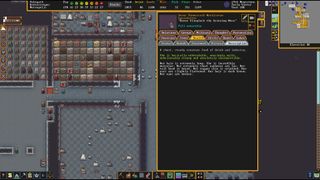
Take out the trash
OK, I know I just told you to wash your hands, but seriously: take out the trash, too. Designate a stockpile outdoors for refuse, then put a Dumping zone over it. Go into the Labor menu and, under the Standing Orders tab, tell your dwarves to dump "other" things. This way they'll take out all their old dirty socks, discarded food trash, and all the teeth that get knocked out in bar brawls. Items in Stockpiles designated for refuse will deteriorate and rot away to nothing faster, especially outdoors, which is good for the overall health of the game simulation. Later on you can make a shaft with a Dump designation over it to toss trash directly into magma for instant disposal, whenever you find some of that.
Or hell, maybe you embarked on a volcano. In that case… get started on the magma-based disposal right away.

Dwarf Fortress diary: How seven drunks opened a portal to Hell
The story of the worst basketball player ever in NBA 2K17's MyCareer mode
Pillars of Eternity diary: playing as a party of bears
Crusader Kings 2 diary: How far can one AI go using wits, skill, and lots of cheats?
We roleplayed Geralt of Rivia in this winery tycoon game
Jon Bolding is a games writer and critic with an extensive background in strategy games. When he's not on his PC, he can be found playing every tabletop game under the sun.
Most Popular






